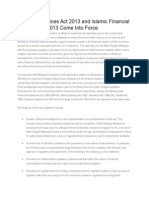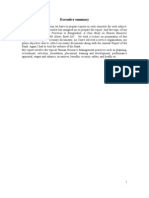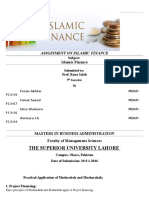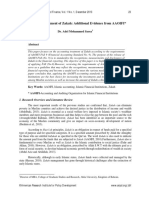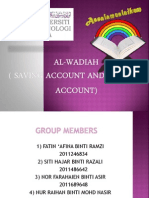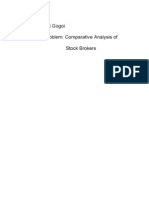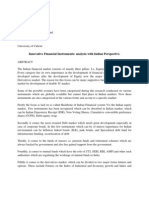AAOIFI - Introduction: 2-How AAOIFI Standards Support Islamic Finance Industry
AAOIFI - Introduction: 2-How AAOIFI Standards Support Islamic Finance Industry
Uploaded by
shahidameen2Copyright:
Available Formats
AAOIFI - Introduction: 2-How AAOIFI Standards Support Islamic Finance Industry
AAOIFI - Introduction: 2-How AAOIFI Standards Support Islamic Finance Industry
Uploaded by
shahidameen2Original Description:
Original Title
Copyright
Available Formats
Share this document
Did you find this document useful?
Is this content inappropriate?
Copyright:
Available Formats
AAOIFI - Introduction: 2-How AAOIFI Standards Support Islamic Finance Industry
AAOIFI - Introduction: 2-How AAOIFI Standards Support Islamic Finance Industry
Uploaded by
shahidameen2Copyright:
Available Formats
AAOIFI Introduction
1- AAOIFI is responsible for formulation and issuance of international Islamic finance
standards.
AAOIFI has issued 80 standards:
- 26 accounting standards,
- 5 auditing standards,
- 7 governance standards (incl. on Sharia supervision),
- 2 codes of ethics, and
- 40 Sharia standards (rules for application of Sharia)
AAOIFI, based in Bahrain, is supported by over 200 institutional members from over 40
countries. Members include:
- Central banks and regulatory authorities,
- Islamic and conventional financial institutions,
- Accounting and auditing professions, and
- Islamic financial support services providers.
So as to support technical application of standards, AAOIFI offers professional qualification
programs:
- Certified Islamic Professional Accountants (CIPA),
- Certified Sharia Adviser and Auditor (CSAA).
2- How AAOIFI Standards Support Islamic Finance Industry.
AAOIFI standards reflect concept and essence of Islamic finance transactions. And bring about
harmonisation of Islamic finance practices. Enhance confidence of users of Islamic finance
products. Promote growth of demand for Islamic finance. AAOIFI standards also ensure
convergence of financial reporting by IFIs. And introduce greater clarity to the financial reports of
IFIs. Promote better view of IFIs financial performances. Enhance transparency of IFIs financial
reports.
3- Comparison on structural objectives:
A. Differences on coverage of standards
AAOIFI
Specific for Islamic finance industry.
Based on requirement of Islamic finance practices.
IFRS
For entire economic and social activities.
Generic, mostly not industry-specific.
B. Differences on types of standards
AAOIFI
All-encompassing.
Accounting,
Sharia,
Auditing, Ethics, and Governance.
IFRS
Type-specific.
Accounting.
4- Categories of accounting standards for IFIs:
1. AAOIFI standards issued because IFRS / IASB standards cannot be adopted in whole by
Islamic financial institutions (IFIs).
2. AAOIFI standards issued for specific Islamic banking and finance practices not covered by
IFRS / IASB standards.
3. IFRS / IASB standards that can be adopted by IFIs (therefore AAOIFI does not issue similar
ones and allows adoption of those standards).
5- IFRS / IASB standards that can be adopted by IFIs
These standards do not give rise to Sharia compliance issues and are adequate to
cover practices of IFIs. In these cases, AAOIFI does not issue equivalent standards
IFIs adopting AAOIFI standards are allowed to also follow other standards if there are
no equivalent AAOIFI standards.
Eg.: IAS 10 (Events after Balance Sheet Dates), IAS 24 (Related Party Disclosures).
Examples of main differences between AAOIFI and IFRS
Investment account funds in IFIs
An IFIs major source of funds is unrestricted investment account funds from its customers.
These funds are generally managed by IFI based on Mudaraba investment management profitsharing agreement.
Under Mudaraba investment management, IFI is not liable for loss arising from investments
(except due to IFIs misconduct, negligence, etc) Sharia standard.
AAOIFI standards require unrestricted investment account funds to be presented in
statement of financial position as a separate item between liabilities and owners equity.
In contrast, based on IFRS these would be presented as liabilities (along with other deposits).
Ijarah (leasing)
An IFIs major financing mechanisms are Operating Ijarah and Ijarah Muntahia Bittamleek
(leasing that ends with transfer of asset ownership to lessee).
For both, asset ownership rests with IFI throughout the lease term.
In Ijarah Muntahia Bittamleek, there must be independent contract for transfer of asset
ownership.
AAOIFI standards require both Operating Ijarah and Ijarah Muntahia Bittamleek to be
treated similar to Operating Lease.
In contrast, based on IFRS, both Operating Ijarah (especially if lease term is for major part of
economic life of lease asset) and Ijarah Muntahia Bittamleek (due to the transfer of asset
ownership by the end of lease term) would normally be classified and treated as Finance Lease.
AAOIFI standards require both Operating Ijarah and Ijarah Muntahia Bittamleek to be
treated similar to Operating Lease.
In contrast, based on IFRS, both Operating Ijarah (especially if lease term is for major part of
economic life of lease asset) and Ijarah Muntahia Bittamleek (due to the transfer of asset
ownership by the end of lease term) would normally be classified and treated as Finance Lease.
You might also like
- CIPA Syllabus Update 2024 - EnglishDocument3 pagesCIPA Syllabus Update 2024 - Englishmezbah.ahmed.2ndNo ratings yet
- Housing Delivery System in The PhilippinesDocument64 pagesHousing Delivery System in The PhilippinesJoshua Buctuan33% (3)
- Capital Structure and Cost of CapitalDocument33 pagesCapital Structure and Cost of CapitaljescataryNo ratings yet
- Py c7 Q MurabahaDocument6 pagesPy c7 Q MurabahaWan KhaidirNo ratings yet
- ACC414 Financial Manageent For Accountants 2Document3 pagesACC414 Financial Manageent For Accountants 2Victor JonesNo ratings yet
- ACC 413 Auditing Inv. 2016-17Document12 pagesACC 413 Auditing Inv. 2016-17Shalini GunaretnamNo ratings yet
- Dela Rama v. Ma-Ao Sugar CentralDocument2 pagesDela Rama v. Ma-Ao Sugar CentralLoi VillarinNo ratings yet
- Aaoifi PDFDocument6 pagesAaoifi PDFInas BennaniNo ratings yet
- AAOIFI - International Islamic Finance StandardsDocument24 pagesAAOIFI - International Islamic Finance StandardsmmaameenNo ratings yet
- MGA3033 Course Outline OBE 1092013Document9 pagesMGA3033 Course Outline OBE 1092013Nur FahanaNo ratings yet
- Structure of Financial System in MalaysiaDocument42 pagesStructure of Financial System in MalaysiaJames CharlieNo ratings yet
- Differences Between Islamic and Conventional AccountingDocument4 pagesDifferences Between Islamic and Conventional AccountingAnis SofiaNo ratings yet
- Islamic Financial Planner - Module One (Revision) Financial Planning Industry in MalaysiaDocument16 pagesIslamic Financial Planner - Module One (Revision) Financial Planning Industry in MalaysiaShahizan Md Noh100% (1)
- FIN20014 Assignment 2015 SP2 - Capital Budgeting AssignmentDocument3 pagesFIN20014 Assignment 2015 SP2 - Capital Budgeting AssignmentAssignment Consultancy0% (1)
- Bank MuamalatDocument286 pagesBank MuamalatMuhammad FadhilNo ratings yet
- Accounting For Musyarakah FinancingDocument16 pagesAccounting For Musyarakah FinancingHadyan AntoroNo ratings yet
- Islamic AccountingDocument9 pagesIslamic AccountingMohamed QubatiNo ratings yet
- Sources and Uses of Funds Islamic BankDocument2 pagesSources and Uses of Funds Islamic BankAkma AseriNo ratings yet
- Financial Services Act 2013 and Islamic Financial Services Act 2013 Come Into ForceDocument3 pagesFinancial Services Act 2013 and Islamic Financial Services Act 2013 Come Into ForceDilawar AheerNo ratings yet
- Accounting For Islamic FinanceDocument459 pagesAccounting For Islamic Financecepi juniarNo ratings yet
- Islamic Accounting Vs Conventional Accounting - Assigment 2Document3 pagesIslamic Accounting Vs Conventional Accounting - Assigment 2ahmedNo ratings yet
- IBP SyllabusDocument12 pagesIBP Syllabuscyrex33100% (1)
- Screening of Sukuk Bonds As Islamic Interbank and Investment ToolDocument44 pagesScreening of Sukuk Bonds As Islamic Interbank and Investment Tooleaboulola100% (1)
- Screening Process in Ftse Shariah Compliance Listed Products Finance EssayDocument18 pagesScreening Process in Ftse Shariah Compliance Listed Products Finance EssayProf. Dr. Mohamed NoorullahNo ratings yet
- Prudential Regulations For Corporate / Commercial BankingDocument73 pagesPrudential Regulations For Corporate / Commercial BankingAsma ShoaibNo ratings yet
- CIMA Islamic Finance Diploma Brochure 09-2012Document8 pagesCIMA Islamic Finance Diploma Brochure 09-2012DiggzBeatz100% (1)
- History of Islamic Banking in PakistanDocument26 pagesHistory of Islamic Banking in Pakistanaamir mumtaz81% (16)
- UDSM MBA Programme DetailsDocument22 pagesUDSM MBA Programme DetailsPoèt WördNo ratings yet
- Introduction To Business FinanceDocument3 pagesIntroduction To Business FinanceFaiza AnsariNo ratings yet
- Regulatory Framework For IBIs-ZahidDocument43 pagesRegulatory Framework For IBIs-Zahidski_leo82No ratings yet
- Islamic Accounting Need or FormalityDocument24 pagesIslamic Accounting Need or Formalityoma1100No ratings yet
- Management Term Paper On Al Arafah Bank's HR Practice Term PaperDocument25 pagesManagement Term Paper On Al Arafah Bank's HR Practice Term Paperratulbinmuzib100% (3)
- Practical Application of Mudarabah and MusharakahDocument7 pagesPractical Application of Mudarabah and MusharakahFaizan Ch50% (2)
- MNG 1200 Lesson 1 - MGMT & Types of OrgsDocument58 pagesMNG 1200 Lesson 1 - MGMT & Types of Orgsricardo mccurchin100% (1)
- WORKING CAPITAL - Meaning of Working CapitalDocument23 pagesWORKING CAPITAL - Meaning of Working Capitalzubair100% (1)
- An Integrated Approach To Beginning Financial Accounting and Finance CoursesDocument39 pagesAn Integrated Approach To Beginning Financial Accounting and Finance CoursesSyukriy AbdullahNo ratings yet
- Profit Distribution MethodsDocument20 pagesProfit Distribution MethodsYoucef Grimes100% (1)
- FIN301-Time Value of MoneyDocument49 pagesFIN301-Time Value of MoneyAbdullah Alosaimi100% (1)
- Stock Valuation - Financial ManagementDocument10 pagesStock Valuation - Financial ManagementNoelia Mc DonaldNo ratings yet
- Chap 06 - MusharakahDocument26 pagesChap 06 - MusharakahhamzaNo ratings yet
- A 11 Internal Reconstruction of A CompanyDocument18 pagesA 11 Internal Reconstruction of A CompanyDhananjay Pawar50% (2)
- Accounting Treatment of Zakah: Additional Evidence From AAOIFIDocument6 pagesAccounting Treatment of Zakah: Additional Evidence From AAOIFIMuhammad SheikhNo ratings yet
- Accounting For Istishna PDFDocument35 pagesAccounting For Istishna PDFVani IndrawatiNo ratings yet
- Business Accounting Course Outline 2021Document7 pagesBusiness Accounting Course Outline 2021Everjoice Chatora100% (1)
- The Impact of Capital-Structure Choice On Firm Performance: Empirical Evidence From EgyptDocument11 pagesThe Impact of Capital-Structure Choice On Firm Performance: Empirical Evidence From EgyptGabriel SimNo ratings yet
- BBCS4103 Integrated Case Study (SG)Document93 pagesBBCS4103 Integrated Case Study (SG)NURUL AMALINA BINTI ROSLI STUDENTNo ratings yet
- BFW3651 Semester 2, 2015 Tutorial 3 Answer GuideDocument6 pagesBFW3651 Semester 2, 2015 Tutorial 3 Answer Guidejiayifjy0% (1)
- PPT3-Measuring and Evaluating Financial PerformanceDocument70 pagesPPT3-Measuring and Evaluating Financial PerformanceAbdul AzizNo ratings yet
- Assessments - mbb4013 Principles and Practices of Islamic BankingDocument7 pagesAssessments - mbb4013 Principles and Practices of Islamic BankingFafaNo ratings yet
- Islamic Derivatives 2Document19 pagesIslamic Derivatives 2syedtahaaliNo ratings yet
- Chapter 2 - Conceptual Framework and Standard Setting Process (Part 2)Document13 pagesChapter 2 - Conceptual Framework and Standard Setting Process (Part 2)Nurul Artikah SariNo ratings yet
- Financial Assets and Liabilities Disclosure Practices in Islamic Banks in MalaysiaDocument22 pagesFinancial Assets and Liabilities Disclosure Practices in Islamic Banks in MalaysiaNurazalia ZakariaNo ratings yet
- ICWIM - EIF - Notes 11Document98 pagesICWIM - EIF - Notes 11Sailesh GoenkkaNo ratings yet
- Ctu 351Document19 pagesCtu 351afinaramziNo ratings yet
- Cafe ProjectDocument15 pagesCafe Projectaqsaamjad07No ratings yet
- Acct4111 Advanced Financial AccountingDocument5 pagesAcct4111 Advanced Financial AccountingWingyan ChanNo ratings yet
- Pakistan Credit Rating Agency LimitedDocument6 pagesPakistan Credit Rating Agency LimitedMubeen MalikNo ratings yet
- IPO Under Pricing and Short Run Performance in Bangladesh - Faisal MahmudDocument54 pagesIPO Under Pricing and Short Run Performance in Bangladesh - Faisal MahmudM. A. Faisal Mahmud75% (4)
- Corporate Finance: Laurence Booth - W. Sean ClearyDocument136 pagesCorporate Finance: Laurence Booth - W. Sean Clearyatif41No ratings yet
- The Islamic Finance Handbook: A Practitioner's Guide to the Global MarketsFrom EverandThe Islamic Finance Handbook: A Practitioner's Guide to the Global MarketsNo ratings yet
- P2 Chapter 6 SlidesDocument14 pagesP2 Chapter 6 Slidesshahidameen2No ratings yet
- P2 Chapter 3 SlidesDocument16 pagesP2 Chapter 3 Slidesshahidameen2No ratings yet
- P2 Chapter 5 SlidesDocument13 pagesP2 Chapter 5 Slidesshahidameen2No ratings yet
- Profit RatesDocument3 pagesProfit Ratesshahidameen2No ratings yet
- Activity Based Costing A Tool To Aid Decision MakingDocument18 pagesActivity Based Costing A Tool To Aid Decision Makingshahidameen2No ratings yet
- Variable Costing and Segment Reporting Tools For ManagemeDocument20 pagesVariable Costing and Segment Reporting Tools For Managemeshahidameen2No ratings yet
- CF 2Document2 pagesCF 2shahidameen2No ratings yet
- Consumer Spending Factors: I) Ageing Population Ii) Higher Consumer Incomes Iii) New Products Iv) Increased ImmigrationDocument1 pageConsumer Spending Factors: I) Ageing Population Ii) Higher Consumer Incomes Iii) New Products Iv) Increased Immigrationshahidameen2No ratings yet
- Strctural Equation ModelingDocument69 pagesStrctural Equation Modelingshahidameen2100% (1)
- Audit Committee Financial Expertise and Audit Report Lag: Malaysia Further InsightsDocument1 pageAudit Committee Financial Expertise and Audit Report Lag: Malaysia Further Insightsshahidameen2No ratings yet
- Lahore Stock Exchange Companies With ContactsDocument223 pagesLahore Stock Exchange Companies With ContactsSarav Anan100% (1)
- Role of Mathematical Languages: A Paradimatic LookDocument53 pagesRole of Mathematical Languages: A Paradimatic Lookshahidameen2No ratings yet
- History:: Exxonmobil Is 2 Company On The Rating of Fortune 500 Magazine in 2010Document3 pagesHistory:: Exxonmobil Is 2 Company On The Rating of Fortune 500 Magazine in 2010shahidameen2No ratings yet
- Pre-Feasibility of Tunnel Farming in BahawalpurDocument10 pagesPre-Feasibility of Tunnel Farming in Bahawalpurshahidameen2100% (1)
- Group 2 - Case 3Document11 pagesGroup 2 - Case 3Gaurav ShroffNo ratings yet
- Analysis of Credit ControlDocument6 pagesAnalysis of Credit ControlMihir ShahNo ratings yet
- Intraday: Trading With TheDocument4 pagesIntraday: Trading With Thepetefader100% (2)
- Accounting TitlesDocument7 pagesAccounting TitlesChar MomozoNo ratings yet
- Synopsis - Manjit GogoiDocument6 pagesSynopsis - Manjit GogoiManjit GogoiNo ratings yet
- Unit-1 Introduction To Managerial EconomicsDocument13 pagesUnit-1 Introduction To Managerial EconomicsAsmish EthiopiaNo ratings yet
- Recovery HeadsDocument660 pagesRecovery HeadsShailendra YadavNo ratings yet
- Womens Fashion VietnamDocument203 pagesWomens Fashion VietnamNatasha Martin100% (1)
- Philippine Law On Joint VenturesDocument21 pagesPhilippine Law On Joint VenturesKeemeeDasCuballes100% (1)
- Internship Report On HBLDocument79 pagesInternship Report On HBLbbaahmad89No ratings yet
- Venture CapitalDocument116 pagesVenture CapitalasdfNo ratings yet
- Banking Industry: Structure and CompetitionDocument37 pagesBanking Industry: Structure and CompetitionZeeruanNo ratings yet
- Sunsilk & Head & ShoulderDocument32 pagesSunsilk & Head & ShoulderRajeev Tripathi100% (1)
- AmericanBasketOptions tcm258-194676Document7 pagesAmericanBasketOptions tcm258-194676hc87No ratings yet
- MGT101 Mega Solved MCQs File For Mid Term ExamDocument85 pagesMGT101 Mega Solved MCQs File For Mid Term ExamObaidNo ratings yet
- Take Home Quiz 1Document9 pagesTake Home Quiz 1Akira Marantal Valdez100% (1)
- Case Study Capital Budgeting PDFDocument151 pagesCase Study Capital Budgeting PDFgigipapas25% (4)
- Partnership HCC CttoDocument7 pagesPartnership HCC CttoKenncy100% (1)
- Oaklrptvotingrecord LibbyDocument301 pagesOaklrptvotingrecord LibbyRecordTrac - City of OaklandNo ratings yet
- Kohinoor ChemicalDocument21 pagesKohinoor ChemicalFaisal AhmedNo ratings yet
- Financial Asset at Amortized CostDocument18 pagesFinancial Asset at Amortized CostJay-L Tan100% (2)
- Income Taxation Chapter 14 SolutionsDocument2 pagesIncome Taxation Chapter 14 SolutionsENo ratings yet
- Spec Pro Outline - SinghDocument10 pagesSpec Pro Outline - SinghHaydn JoyceNo ratings yet
- IRR Calculations Through InterpolationDocument11 pagesIRR Calculations Through InterpolationMuhammad azeem AshrafNo ratings yet
- Choosing Options Strategy Guide PDFDocument19 pagesChoosing Options Strategy Guide PDFJeffNo ratings yet
- Investment IdeasDocument3 pagesInvestment IdeasJohn DoeNo ratings yet
- Innovative Financial Instruments in IndiaDocument31 pagesInnovative Financial Instruments in Indiariyasacademic50% (4)
- Puerto Rico Capital Fund, LLC.Document84 pagesPuerto Rico Capital Fund, LLC.Marc BaronNo ratings yet


















